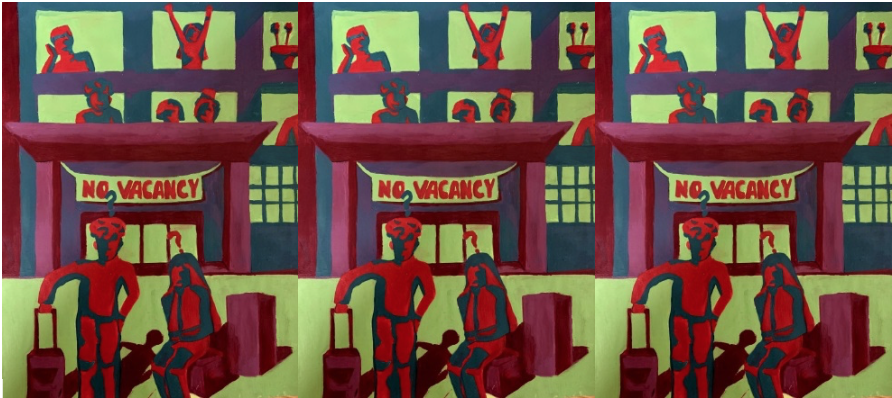CommentsGUEST VIEWPOINT-UCLA is playing Jenga with students. And soon enough, it’ll all come crashing down.
UCLA’s large undergraduate population warrants the need for additional housing. More accessible housing has long been something both the administration and student body have agreed on. New housing projects have swelled to match the campus’ growing student body.
Upcoming housing projects include building dorms on the Lot 15 site, which will provide 1,781 beds; redeveloping an older building to construct the Margan Apartments, which will provide 216 beds; and constructing apartments in the southwest part of campus, which will provide 321 graduate beds and 1,958 upper-division undergraduate beds.
The cycle of adding new buildings, enrolling more students, using the revenue to add new buildings and proceeding to enroll more students has served UCLA well. But space on and around campus has been dwindling due to the university’s new buildings and projects. The situation becomes more dire when you consider the fact that today’s undergraduate body is hundreds of students larger than it was five years ago.
This is largely due to recent state mandates. The University of California accepted additional funding from California when it enrolled 10,000 more in-state students, spread across three years beginning in fall 2016. The increase in students inevitably leads to less room on campus and fewer housing options. More housing projects have to be proposed to account for a larger student population, which leads to less space on campus, forming a vicious cycle – the very same that UCLA had employed so successfully in the past.
This cycle of building new buildings and dealing with population problems as they come has worked but is unreliable in the upcoming years due to increasingly scarce space. The university needs to re-evaluate its policies in light of this and consider how it’s going to house students in the long term.
UCLA nonresident student population is capped at 22 percent, and it tends to reach that cap every year, said Gary Clark, UCLA’s undergraduate admissions director.
From an economic perspective, this makes sense: UCLA gets roughly $29,000 more in tuition from out-of-state students than in-state students, which is why the percentage of nonresident students was increasing until the state government capped it in 2017.
“Admissions rates for out-of-state students could potentially be a problem because the state isn’t mandated to admit a minimum number of nonresident students,” said Rashed Alkhlaifat, a third-year materials engineering student.
As a public university, UCLA’s first and foremost responsibility is to its students. Prioritizing out-of-state admissions because of the money it brings in contradicts that idea, especially considering we already have a housing problem on campus. UCLA can’t grow indefinitely, and Westwood’s community has already pushed against its growth.
The Agora building, a private housing venture in Westwood intended for students, was proposed to city planners at more than four times the height and three times the square footage allowed by the area’s zoning laws, inciting a petition against it from local homeowners.
By all intents and measures, The Agora indicates a point where housing can no longer match the student population. Projects like this should be unnecessary: They disrupt and disregard zoning laws. This is reflective of the root cause behind the overwhelming housing demand in Westwood: the student body’s size.
Anthony Andrade, a fourth-year economics student, said housing is a real issue on campus that new projects would help resolve.
“UCLA has expensive, competitive housing because of how many students we have,” Andrade said. “The solution is to keep building housing complexes.”
Freshman Bruins are guaranteed three years of housing and transfers are guaranteed one. Ideally, students should be guaranteed housing regardless of what year they’re in.
“A large part of the university’s goal is to guarantee four years of housing for freshmen and two years for transfers,” Clark said.
But this is a goal the university’s plans have yet to attain. The fact that this goal hasn’t been realized is indicative of UCLA’s inability to properly support the students it currently has. Additional housing addresses the problem we currently have, but it doesn’t ameliorate the problems we will have as the student body grows.
“I think (UCLA) tries to accommodate everyone – we try – but it’s simply too populated,” said Sydney To, a first-year physiological science student. “UCLA is already the smallest campus with the largest student body in the UC system.”
A decrease in out-of-state students’ enrollment rate would help offset mandates regarding in-state students, as well as help the university more quickly reach its goal of four years of guaranteed housing for freshmen and two years for transfers.
There will be a time when the university cannot continue to support a growing student body. Perhaps that time is now.
It’s undeniable UCLA would suffer from lowering the number of out-of-state students. But the school would be able to either slow down the timelines or halt projects in lieu of a larger undergraduate body, saving time and money in the process. More importantly, it’s UCLA’s responsibility to pay more attention to the students it has, not the students that it will have.
Students aren’t wooden blocks that can be pulled out and placed atop one another. And even if they were, UCLA is running out of space to stack them.
(Srikanth Raguraman is an Opinion columnist and News contributor at the UCLA Daily Bruin.) Prepped for CityWatch by Linda Abrams.
















